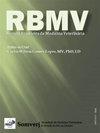Geographical distribution of sporotrichosis in the municipality of Campos dos Goytacazes, Rio de Janeiro
Q4 Veterinary
引用次数: 1
Abstract
Sporotrichosis is a cutaneous mycosis, it´s etiological agent belongs to the genus Sporothrix . The zoonotic transmission has become the major form of the disease aquisition in Brazil, and the state of Rio de Janeiro has been pointed as the epicenter of the epidemic of sporotrichosis in the country. The notifications of positive cases are currently rising, both in humans and domestic animals, so that the disease is related to hospitalizations and deaths in Brazil, demonstrating it’s relevance to the public health. The objective of this paper is to describe the spacial data of the zoonosis in Campos dos Goytacazes, RJ, demonstrating it’s evolution in the period from 2016 to 2019. The diagnosis was made by collecting material from suspected lesions of cats and dogs with the aid of sterile swab and the diagnosis was realized through culture on 4% Sabouraud dextrose agar plus chloramphenicol and cyclohexamide incubeted at 25-30°C, for approximately 10 to 15 days. The results demonstrated that there was a wide spread of the disease throughout the city in the period studied, with an increase on the number of positive cases and neighborhoods afected. The high incidence of cases and evolution of the geografical distribution of sporotrichosis in the municipality during the analyzed period reveal great concern related to public health in the region.巴西里约热内卢坎波斯多斯戈伊塔卡泽斯市孢子虫病的地理分布
孢子菌病是一种皮肤真菌病,其病原属于孢子菌属。人畜共患传播已成为巴西疾病获取的主要形式,里约热内卢州已被指定为该国孢子虫病流行的中心。目前,报告的人类和家畜阳性病例都在增加,因此,这种疾病与巴西的住院和死亡有关,表明它与公共卫生有关。本文的目的是描述RJ Campos dos Goytacazes人畜共患病的空间数据,展示其在2016 - 2019年期间的演变。通过无菌拭子收集疑似猫和狗病变的材料进行诊断,并通过4% Sabouraud葡萄糖琼脂加氯霉素和环己胺在25-30℃下培养约10 - 15天进行诊断。结果表明,在研究期间,该疾病在整个城市广泛传播,阳性病例和受影响社区的数量都有所增加。在分析期间,该市孢子虫病的高发病率和地理分布的演变表明,该地区的公共卫生受到高度关注。
本文章由计算机程序翻译,如有差异,请以英文原文为准。
求助全文
约1分钟内获得全文
求助全文
来源期刊
CiteScore
0.80
自引率
0.00%
发文量
34
审稿时长
>12 weeks
期刊介绍:
The Brazilian Journal of Veterinary Medicine was launched in 1979 as the official scientific periodical of the Sociedade de Medicina Veterinária do Estado do Rio de Janeiro (SOMVERJ). It is recognized by the Sociedade Brasileira de Medicina Veterinária (SBMV) and the Conselho Regional de Medicina Veterinária do Estado do Rio de Janeiro (CRMV-RJ).

 求助内容:
求助内容: 应助结果提醒方式:
应助结果提醒方式:


